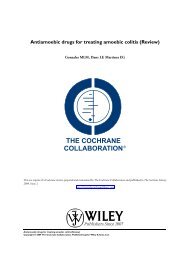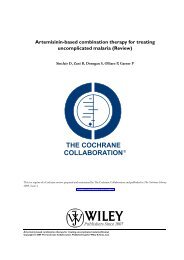Ivermectin for onchocercal eye disease (river blindness) (Review)
Ivermectin for onchocercal eye disease (river blindness) (Review)
Ivermectin for onchocercal eye disease (river blindness) (Review)
You also want an ePaper? Increase the reach of your titles
YUMPU automatically turns print PDFs into web optimized ePapers that Google loves.
D I S C U S S I O N<br />
Summary of main results<br />
This review includes the results of two different types of studies:<br />
two small studies in which people with <strong>onchocercal</strong> infection were<br />
given one dose of ivermectin or placebo and followed up <strong>for</strong> one<br />
year; and two larger community-based studies whereby all individuals<br />
in selected communities were treated every six or 12 months<br />
with ivermectin or placebo, whether or not they were infected,<br />
and followed <strong>for</strong> two to three years.<br />
As the two types of studies are addressing two different questions<br />
we will consider them separately.<br />
1. <strong>Ivermectin</strong> to prevent and treat <strong>onchocercal</strong> <strong>eye</strong> <strong>disease</strong> and<br />
its consequences in people infected with O.volvulus<br />
See ’Summary of findings <strong>for</strong> the main comparison’.<br />
The results of Dadzie 1989 and Taylor 1988 provide evidence that<br />
treating people who have onchocerciasis with ivermectin reduces<br />
the number of microfilariae in their skin and <strong>eye</strong> (not shown in<br />
the Summary of findings table) and reduces the number of punctate<br />
opacities. There was weaker evidence that ivermectin reduced<br />
the risk of chorioretinitis. There was no evidence <strong>for</strong> a protective<br />
effect <strong>for</strong> sclerosing keratitis, iridocyclitis, optic nerve <strong>disease</strong> or<br />
visual loss. However, the studies were too small and of too short a<br />
duration to provide evidence on these less frequent consequences<br />
of <strong>onchocercal</strong> infection.<br />
2. <strong>Ivermectin</strong> to prevent and treat <strong>onchocercal</strong> <strong>eye</strong> <strong>disease</strong> in<br />
people living in communities affected by O.volvulus<br />
See ’Summary of findings 2’.<br />
The results of one community-based study provides evidence that<br />
annual mass treatment with ivermectin reduces the risk of new<br />
cases of optic nerve <strong>disease</strong> and visual field loss in communities<br />
mesoendemic <strong>for</strong> the savannah strain of O.volvulus (Abiose 1993).<br />
The other community-based study, with mass biannual treatment<br />
of ivermectin in communities affected by the <strong>for</strong>est strain, demonstrated<br />
reductions in microfilarial load (not shown in the Summary<br />
of findings table), punctate keratitis and iridocyclitis but not<br />
sclerosing keratitis, chorioretinitis, optic atrophy or visual impairment<br />
(Whitworth 1991). However, the study was underpowered<br />
to estimate the effect of ivermectin on visual impairment and other<br />
less frequent clinical signs. Only a small number of new cases of<br />
visual impairment developed over two years (11 cases in total, not<br />
all of which could be attributed to onchocerciasis).<br />
Adverse effects<br />
In Whitworth 1991 ivermectin was associated with a higher prevalence<br />
of adverse drug reactions compared to placebo, however, this<br />
was not statistically significant. Dadzie 1989 showed a nine-fold<br />
increased risk of severe symptomatic postural hypotension in the<br />
ivermectin group but this was not statistically significant.<br />
<strong>Ivermectin</strong> <strong>for</strong> <strong>onchocercal</strong> <strong>eye</strong> <strong>disease</strong> (<strong>river</strong> <strong>blindness</strong>) (<strong>Review</strong>)<br />
Copyright © 2009 The Cochrane Collaboration. Published by John Wiley & Sons, Ltd.<br />
Overall completeness and applicability of<br />
evidence<br />
With only four trials included in this review, the evidence <strong>for</strong> ivermectin<br />
in the treatment of <strong>onchocercal</strong> <strong>disease</strong> is incomplete. We<br />
can say with confidence that ivermectin reduces the microfilarial<br />
load and number of punctate opacities. However, the evidence <strong>for</strong><br />
its effect on other signs of <strong>onchocercal</strong> <strong>eye</strong> <strong>disease</strong>, such as sclerosing<br />
keratitis, chorioretinitis and optic nerve <strong>disease</strong> is less certain.<br />
Most importantly, the effect of ivermectin in preventing visual<br />
loss, which is an outcome of primary importance to people suffering<br />
from <strong>river</strong> <strong>blindness</strong>, is unclear. The trials included in this<br />
systematic review were not primarily designed to evaluate the effectiveness<br />
of ivermectin in preventing <strong>onchocercal</strong> <strong>blindness</strong> and<br />
this outcome was not commonly reported. The lack of evidence<br />
<strong>for</strong> prevention of visual impairment and <strong>blindness</strong> should not be<br />
interpreted to mean that ivermectin does not have these effects,<br />
however, clearly this is a key question that remains unanswered.<br />
Only two community-based trials are included in this review, one<br />
conducted in communities mesoendemic <strong>for</strong> savannah strain in<br />
northern Nigeria and one in communities affected by the <strong>for</strong>est<br />
strain in Sierra-Leone. The Nigerian study demonstrated a protective<br />
effect of mass treatment with ivermectin on the incidence<br />
of optic nerve <strong>disease</strong> and visual field loss. However, it is unclear<br />
whether this finding applies to other communities with higher or<br />
lower infection rates and to communities affected by other strains<br />
of O.volvulus. Several reports suggest that <strong>onchocercal</strong> <strong>blindness</strong><br />
is less common in <strong>for</strong>ested areas compared to savannah areas,<br />
where <strong>blindness</strong> rates can reach 15% (Burnham 1998; Pond 1991;<br />
Stevenson 1999; WHO 1985). It is believed that the savannah<br />
strain is more aggressive than the <strong>for</strong>est strain. These factors could<br />
influence the overall response of participants to the treatment being<br />
evaluated.<br />
The studies included in this review reported some adverse effects,<br />
in particular an increased risk of postural hypotension in people<br />
treated with ivermectin. Unlike diethylcarbamazine, ivermectin<br />
does not rapidly eliminate microfilariae. This means that the Mazzotti<br />
reaction, which results from a massive overkill of numerous<br />
macrofilariae all at once, is unlikely to be serious with ivermectin.<br />
However, none of the studies have been conducted in areas where<br />
people are infected with Loa loa (loaisis). Some studies have suggested<br />
that serious neurological adverse effects can occur when<br />
ivermectin is given to people with heavy infections of Loa loa (<br />
Gardon 1997).<br />
Quality of the evidence<br />
All the trials included in this review used a placebo-controlled<br />
group and there<strong>for</strong>e outcome assessment was graded as a low risk of<br />
bias. The use of a placebo probably meant that sequence generation<br />
and allocation concealment were adequate as well but this was less<br />
well reported. In<strong>for</strong>mation on follow-up was less well reported<br />
24








